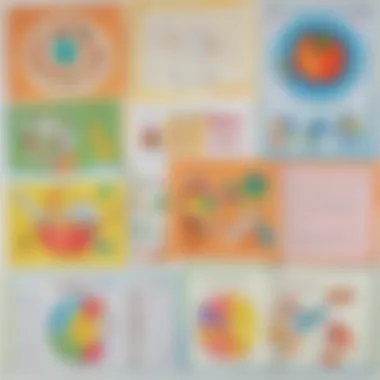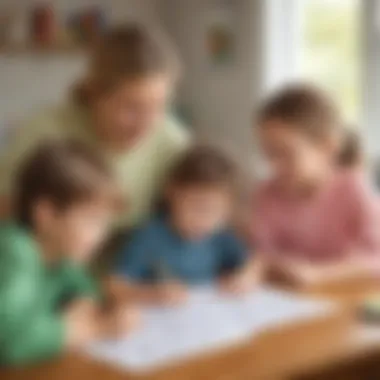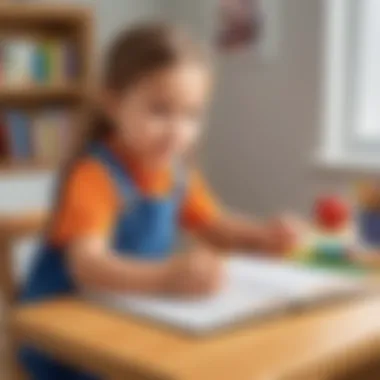Printable Learning Worksheets for Four-Year-Olds


Intro
Printable learning worksheets serve as a valuable tool for early childhood education, particularly for four-year-olds. At this age, children are like sponges; they eagerly soak up new information and skills, paving the way for more complex learning ahead. Using worksheets can transform abstract concepts into tangible, manageable tasks that little hands can handle.
These resources are diverse and adaptable, ensuring that every child's learning needs are met. From simple counting exercises to more creative activities involving colors and shapes, there's something for every curious mind. However, it isn’t just about filling in blanks or coloring inside the lines.
The right worksheets nurture a love for learning, while also allowing for fun and creativity. Before diving into the specifics of worksheets, let’s first explore ways to keep young learners engaged through various activities.
Fun Activities Ideas
Engaging children in learning through play is vital, as it blends education with enjoyment. There’s a treasure trove of fun activity ideas that can complement printable worksheets, ensuring that little ones learn not only through structured tasks but also through experiential play.
Indoor Activities
Indoor activities offer an ideal way to keep four-year-olds engaged when the weather isn’t cooperating. Consider these ideas:
- Obstacle Course: Set up household items to create a mini-obstacle course. It helps in developing motor skills and following directions.
- Treasure Hunt: Write simple sight words or clues on strips of paper and hide them around the house. This combines reading and excitement.
- Puzzle Time: Work on age-appropriate puzzles. It builds critical thinking and problem-solving skills.
Outdoor Adventures
When the sun is shining, outdoor activities bring a completely different energy to learning.
- Nature Walks: Collect leaves, flowers, or stones, and discuss colors and shapes as you go.
- Chalk Art: Use sidewalk chalk to create art and practice writing letters or numbers.
- Scavenger Hunt: Create a list of items for your child to find in your backyard or a nearby park.
Arts and Crafts
Arts and crafts can beautifully tie in with printable worksheets.
- Custom Puppets: Make puppets from paper bags and use them to act out stories or lessons.
- Collages: Collect old magazines and let kids cut out pictures and glue them on paper, combining creative expression with fine motor skills.
- DIY Sorting Activities: Create sorting games with colored buttons or blocks.
Science Experiments
Simple science activities can spark curiosity while reinforcing concepts.
- Baking Soda Volcano: A classic experiment that combines learning about reactions with a bit of kitchen fun.
- Planting Seeds: Grow herbs or flowers and discuss the plant life cycle.
- Nature Observation: Collect bugs or observe birds in the yard and talk about their characteristics.
Cooking and Baking
Cooking in the kitchen isn’t just about making food; it’s also a great opportunity to learn.
- Measuring Ingredients: Teach basic math and measurements while baking cookies or making a favorite dish.
- Healthy Snack Preparation: Involve your child in making fun, healthy snacks—this also teaches nutrition.
- Culinary Creations: Let kids decorate cupcakes or pizzas, encouraging creativity and independence.
Engaging activities like these not only bring joy but also develop essential skills. They act as the icing on the cake when combined with printable worksheets, offering a well-rounded experience for four-year-olds.
Remember: Learning through play is the best kind of learning at this age. It keeps children's minds active and willing to explore.
As we progress through this guide, we will explore educational games, seasonal activities, parenting tips, and much more—all aimed at making the learning journey of four-year-olds exciting and effective.
Preface to Printable Learning Worksheets
In the realm of early childhood education, printable learning worksheets serve as a valuable resource that bridges the gap between structured learning and playful engagement. These materials, specifically designed for four-year-olds, hold tremendous significance in nurturing a child's cognitive, emotional, and social development. Worksheets not only provide a platform for children to explore various subjects but also encourage them to engage in activities that are both fun and educational.
Making worksheets accessible for young learners is akin to laying down the building blocks of knowledge. For parents and educators alike, understanding the role that these learning tools play can lead to more effective teaching strategies. What makes printable worksheets particularly beneficial is their versatility; they can be tailored to meet individual learning paces and styles, ensuring that every child, regardless of their background, has a chance to flourish in their early educational journey.
When we discuss the importance of printed worksheets, it’s essential to consider the myriad ways in which they can contribute positively to a child’s learning environment. Here are some key elements to keep in mind as you explore this indispensable educational resource:
- Facilitation of Active Learning: Worksheets encourage kids to think critically and creatively while completing tasks.
- Development of Fine Motor Skills: Activities often involve writing, cutting, or coloring, honing their dexterity and coordination.
- Reinforcement of Concepts: Worksheets help solidify lessons taught in classrooms, reinforcing understanding through repetition and practice.
- Encouragement of Independent Learning: They provide kids with opportunities to work independently, which builds confidence and self-directed learning habits.
Ultimately, the introduction of printable learning worksheets is a crucial step in curating an effective early education landscape. Through these resources, young learners not only acquire knowledge but also foster a love for learning that can last a lifetime.
The Role of Worksheets in Early Education
Printable worksheets act as concrete tools in the abstract world of learning for young learners. They stand as guides that facilitate exploration of new topics and skills in an engaging manner. In a setting where attention spans may be short, worksheets break down complex subjects into manageable bites.
Instead of merely reciting what they learned, children can put their knowledge to the test. For instance, a math worksheet that presents simple addition problems in a playful format allows a child to visualize numbers rather than view them as mere symbols on a page.


This dynamic engagement helps youngsters to grasp challenging ideas while developing critical thinking abilities and problem-solving skills.
Moreover, worksheets can be designed to cater to various developmental levels, offering customization that meets the learner’s needs. As a result, worksheets help educators keep a pulse on each child's progress, identifying areas of strength and pinpointing where further assistance may be required.
Understanding Developmental Needs of Four-Year-Olds
At four years old, children are like sponges; they soak up knowledge and experiences from their surroundings. It is crucial for parents and educators to acknowledge the unique developmental milestones that occur at this age. Cognitive growth, linguistic development, and social skills are all blossoming simultaneously.
As young children navigate a world filled with colors, shapes, and sounds, printable worksheets that engage these specific areas become invaluable. They not only introduce new concepts but also encourage children to make connections, enhancing their understanding of the world around them. Consider the following developmental aspects:
- Cognitive Development: Worksheets can challenge children with simple problem-solving tasks, promoting critical thinking.
- Language Skills: Engaging worksheets with storytelling elements or vocabulary activities support language acquisition and comprehension skills.
- Social Skills: Collaborative worksheet activities can promote turn-taking, sharing, and communication among peers.
By aligning worksheets with the developmental needs of four-year-olds, parents and educators can create a supportive landscape that fosters growth, learning, and creativity.
Types of Printable Worksheets
When it comes to nurturing the young minds of four-year-olds, widely available printable worksheets offer a unique mix of structure and creativity. They are not just mere sheets of paper; they are vital tools that cater to different developmental areas. These workshets can enhance early education from various fronts, whether it’s motor skills through coloring or cognitive skills with math problems. Because kids at this age are curious learners, different types of worksheets can keep their interest piqued and learning outcomes elevated.
Coloring and Art Worksheets
Coloring and art worksheets are like an open canvas for four-year-olds. These worksheets provide a platform for self-expression, allowing children to explore their creativity while fine-tuning their motor skills. When they grasp a crayon or paintbrush, they are not just having fun; they are improving hand-eye coordination and learning to control their movements.
Offers an art-based activity that’s both simple and enjoyable is important. One can find coloring sheets that introduce animals, seasonal themes, or even basic shapes. As they fill in colors, they also learn about colors and concepts like shading and blending. Moreover, these worksheets can foster imagination, allowing kids to add their own flair to the templates.
"Art washes away from the soul the dust of everyday life."
Number and Math Worksheets
Number and math worksheets help lay the groundwork for mathematical understanding. Four-year-olds are often ready to explore counting, simple addition, and even basic subtraction through fun activities. Worksheets that involve counting objects, matching numbers to quantities, or solving simple number puzzles can be both engaging and educational.
These kinds of activities can bring numbers to life for young learners. They can explore math concepts without it feeling like work. For example, worksheets might include puzzles where kids can match numbers with images of items, like finding three apples to the number '3'. Engaging in practical math makes the learning experience organic and straightforward.
Letter and Writing Worksheets
Focusing on letters and writing, worksheets provide a structured approach to learning the alphabet. Four-year-olds are typically ready to start recognizing letters and making connections between sounds and symbols. Worksheets can offer tracing letters or constructing simple words, enabling practice in letter formation and recognition.
Engaging tools like letter-matching games or word searches targeted for their age level can keep the learning environment lively and interactive. Kids are more likely to remember letters when they can do something fun with them, such as colorful activities that incorporate the characters of a beloved cartoon.Working with worksheets encourages them to express written ideas from an early stage, establishing confident learners in the longer run.
Shape and Pattern Recognition Worksheets
Shapes and patterns are fundamental concepts for four-year-olds that enhance spatial awareness. Worksheets focused on this area help young learners identify basic shapes like circles, triangles, and squares. Activities might require kids to find and match shapes, or even fill in patterns using stickers.
Recognizing shapes and patterns lays the groundwork for problem-solving, critical thinking, and reasoning skills. It’s vital for children to understand the world around them through shapes; who can miss the square window in their home? By providing sheets that introduce this concept graphically, learning becomes an exciting adventure rather than a mundane task.
Social Skills and Emotional Worksheets
Social skills and emotional worksheets are pivotal as they assist in teaching four-year-olds about feelings and interactions with others. At this young age, children are starting to navigate friendships, share, and understand emotions. Worksheets that facilitate conversations about feelings or scenarios can greatly aid in emotional intelligence development.
Activities can include role-playing worksheets where children choose how a character might feel in a given situation. Others might foster discussions around sharing and cooperation, reinforcing these essential social skills. Encouraging children to express themselves through these worksheets can help develop not just their social aptitudes but also their empathy towards others.
Benefits of Using Printable Worksheets
Printable worksheets offer a host of advantages that can significantly impact the learning journey of four-year-olds. These resources blend education with engagement, making them a vital tool in early childhood development. Here are several specific benefits that highlight why incorporating these worksheets is essential in a child's learning environment.
Encouraging Independent Learning
One of the hallmark benefits of using printable worksheets is their ability to foster independent learning. Worksheets can empower children to explore concepts at their own pace, which is crucial at this stage of development. Instead of simply following instructions given by teachers or parents, kids can navigate through the worksheets independently.
For example, a worksheet that asks a child to count and color a series of objects encourages them not just to complete a task, but also to think critically about the activities involved. They learn responsibility as they take ownership of their work. This measure of independence can boost a child’s self-esteem, making learning more impactful and enjoyable.
Reinforcing Concepts Taught in Class
The use of printable worksheets also plays a key role in reinforcing concepts taught in class. Kids often need opportunities to practice what they have learned, and worksheets provide a structured way to do just that.
Using a worksheet to practice letter writing, for example, helps to solidify what a child has seen and heard during their lessons. When a child writes letters or words on a worksheet, they engage in a tangible exercise that enhances recall and comprehension. This reinforcement is particularly beneficial in retaining information and achieving academic milestones. In addition, worksheets can be revisited, allowing children to review and refresh their understanding over time.


It’s not just about getting the right answer. It’s about developing the skills needed to solve problems and express ideas.
Flexible Learning Opportunities
Another notable advantage of printable worksheets is the flexibility they offer in terms of learning environments. These resources can be utilized at home, in classrooms, or even on the go.
Parents and educators can print a variety of worksheets to cater to different moods and scenarios. If a child seems restless, a fun puzzle or coloring sheet can change the pace and re-engage focus. Conversely, if they are eager to learn something new, a math worksheet can challenge their abilities. This adaptability allows for a more personalized educational experience, addressing the unique learning styles and needs of each child.
These advantages make it clear that printable worksheets aren’t merely supplementary tools; they’re integral to creating a robust, engaging, and effective learning environment.
Choosing Quality Worksheets
When it comes to printable worksheets for four-year-olds, selecting quality materials can make a world of difference. High-quality worksheets not only foster learning but also cater to the developmental needs specific to this age group. Worksheets that are educationally rich, engaging, and visually appealing can capture a child’s interest, making the learning process enjoyable rather than a chore. Moreover, the right worksheets reinforce the skills taught in the classroom, thus creating a favorable environment for both learning and retention.
Evaluating Educational Value
Determining the educational value of a worksheet goes beyond just checking if it covers the right topics. One must look at how these activities enforce key developmental milestones, such as fine motor skills, language acquisition, and cognitive processing. A good worksheet should promote, not just rote memorization, but critical thinking and independence. Consider whether the worksheet presents challenges appropriate to the child's level, encouraging problem-solving and creativity.
Key points to evaluate include:
- Clarity of Instructions: Are the prompts clear enough for a four-year-old to understand, ideally encouraging self-guided learning?
- Alignment with Educational Standards: Does it meet specific learning objectives outlined for early childhood education?
- Diversity of Activities: Are there varied exercises that cater to different learning styles, such as visual, auditory, and kinesthetic?
Ultimately, a worksheet’s value lies in its ability to stimulate thought and promote a sense of achievement in young learners.
Considering Age Appropriateness
Age appropriateness cannot be overstated when choosing worksheets. Four-year-olds are at a delicate stage of development where tasks that are too complex can lead to frustration, whereas those that are too simple might bore them. Consequently, carefully assessing the difficulty level of the activities plays a vital role.
Look for:
- Developmentally Suitable Content: Ensure the content and skills being taught are suitable for a child of this age, like basic numercial or letter recognition.
- Complexity of Tasks: Activities should gradually increase in complexity, allowing for skill progression. A worksheet aiming for critical thinking may start simple with visual sorting and build up towards more intricate tasks like simple addition or storytelling.
- Time Frame for Completion: Worksheets should be designed to be completed within a reasonable time. Overly lengthy tasks can deter a child's focus and interest.
Assessing Visual Appeal and Engagement
Visual appeal is a crucial aspect of worksheets geared toward young learners. A visually stimulating worksheet not only captures a child's attention but also encourages them to interact more deeply with the material. Bright colors, fun characters, and engaging illustrations can transform a simple worksheet into an inviting learning tool.
Things to keep in mind include:
- Color Usage: Vibrant colors can enhance engagement, but they should not be overwhelming. A good balance helps maintain focus without causing distraction.
- Graphics and Layout: Graphics that align with the activity's theme not only make the worksheet attractive but can also help in clarifying instructions. A cluttered layout can confuse rather than help.
- Interactive Elements: Worksheets that allow some form of interaction, such as cutting, pasting, or drawing, can enhance both engagement and enjoyment. These elements can make even simple tasks feel like play rather than work.
In short, once you prioritize evaluating educational value, age appropriateness, and visual appeal, you'll be setting the stage for a rich learning experience in your four-year-olds, making the task at hand feel less like an obligation and more like an adventure.
Incorporating Worksheets into Play
Incorporating worksheets into playtime can transform a seemingly mundane task into an engaging adventure. It’s crucial to recognize that at the core of a four-year-old's world is play. Thus, weaving educational materials into this fabric of fun not only enhances the learning experience but also solidifies concepts in a child’s mind. This incorporation isn't merely about handing a child a worksheet; it’s about crafting an environment where the worksheet serves as a tool for exploration and enjoyment.
Balancing Learning with Fun
Finding the sweet spot between education and play is essential. First off, worksheets should be inviting, colorful, and relate to activities that pique a child's curiosity. For instance, if a child is fascinated with animals, a worksheet featuring animal-related coloring activities or counting exercises can spur their interest. In this way, the worksheet becomes less of an obligation and more of a journey through a child's interests.
Moreover, parents or educators can enhance the play experiences connected to the worksheets. Instead of just solving a math problem on paper, one can set up a scavenger hunt that requires finding specific items that kids can count or categorize. This not only reinforces the concept but also makes the child feel as if they are part of an exciting discovery.
"Learning through play cultivates curiosity and creativity, which are vital skills for lifelong learning."
Balancing learning with fun also involves mixing activities. Regularly alternating between worksheet time and active play keeps the motivation fresh. Parents can utilize simple timers to ensure that children engage in a rhythm of activity—some worksheet time followed by free play or outdoor exploration. This variation in routine invites enthusiasm and reduces the sense of monotony, allowing children to approach their worksheets with a lively spirit.
Strategies for Interactive Learning
To truly elevate the experience of incorporating worksheets into play, interactive strategies can be employed. One engaging way is through collaborative learning exercises. Invite peers or even siblings to join in on the fun. Children can work together to complete worksheets, exchanging ideas and solutions while chatting. This form of learning allows them to understand different perspectives and boosts their social skills at the same time.
Another effective strategy is to gamify the worksheets. Transform standard exercises into quests with rewards for completed tasks. For example, using stickers or stamps as rewards can encourage kids to strive for excellence in their worksheets. When children associate positive outcomes or fun elements with completing educational tasks, their motivation soars.
Lastly, incorporating technology can also add an interactive layer to the worksheets. There are various applications that allow children to complete worksheets digitally. Many of these apps include dynamic, animated elements that engage children’s senses. The incorporation of sound effects or animations often captivates children and holds their attention much longer.
In summary, by blending worksheets into playful scenarios, we cultivate an environment where learning feels less like a chore and more like an exciting adventure. It’s about iproviding children an opportunity to explore, discover, and learn in an enjoyable manner, ensuring they retain knowledge while having a good time.


Digital Resources and Printability
In today's fast-paced world, digital resources have become a bedrock of learning, especially for the youngest learners. For four-year-olds, engaging with interactive content is not just a luxury; it's becoming a necessity. Printable learning worksheets serve as a bridge between the tangible and the digital, offering variety and flexibility in how children interact with educational material. Understanding the significance of these resources helps parents and educators make informed choices that resonate with developmental milestones.
One of the primary benefits of utilizing digital resources is the accessibility they provide. Online platforms host an array of free worksheets that are easy to download and use, making it feasible for parents and teachers to enrich their curriculum without breaking the bank. The sheer convenience cannot be overstated; gone are the days when one had to scour stores for suitable materials. Just a few clicks can yield a treasure trove of worksheets.
Moreover, printability allows tailoring of learning experiences to fit individual needs. Every child is different, and what fits one child may not suit another. With digital resources, parents can choose the activities that will best appeal to their child’s interests, thereby cultivating a love for learning.
Taking a closer look at the different avenues for accessing these worksheets, let’s explore how free printable worksheets online and educational apps and software contribute to an enriching learning experience.
Accessing Free Printable Worksheets Online
This part of the digital landscape is a veritable gold mine for educators and parents alike. Websites such as education.com and teacherspayteachers.com offer a vast selection of printable resources tailored specifically for preschoolers. Free worksheets are often available, covering subjects like math, reading, and arts. This facet makes them not only appealing but also budget-friendly.
When searching for these resources, there's a few thing to keep in mind:
- Quality Matters: Not all worksheets are created equal. Look for sources that provide engaging, age-appropriate, and educationally valuable content.
- User Ratings: Checking ratings and comments from other users can help determine the utility of particular worksheets before downloading.
- Variety: Choose platforms that offer a wide range of choices to keep the learning experience diverse and piquant.
With these online resources, parents can continually refresh their child’s learning materials, ensuring that they remain engaged and eager to learn.
Utilizing Educational Apps and Software
As technology has made its mark on education, educational apps and software come into play, offering dynamic ways for young learners to interact with concepts. Apps like Starfall and Endless Alphabet mix fun with learning, providing interactive environments where children can explore numbers, letters, and even basic science concepts. Educational software is designed not only to educate but also to keep children entertained. The immediate feedback that children receive from these applications is highly encouraging. Failure becomes a learning opportunity, rather than a setback.
When selecting apps for four-year-olds, here’s a few guidelines to follow:
- Content: Ensure that the app covers educational objectives that align with learning goals.
- User-Friendly Interface: The interface should be intuitive and simple, allowing young children to navigate easily without frustration.
- Screen Time Management: Monitor usage to prevent excessive screen time. Balance is key, so incorporating worksheets alongside app usage can create a well-rounded educational experience.
Educational resources have evolved, and with the right approach, parents can foster an environment where learning is not only effective but also enjoyable. In this age of technology, printable worksheets and digital resources can go hand in hand, paving the way for a fruitful educational journey.
Parental and Teacher Collaboration
Collaboration between parents and teachers is more than just a nice-to-have; it’s essential for nurturing the development of four-year-olds. When parents and teachers join forces, the child benefits from a cohesive learning environment that propels their growth. Here’s why this partnership is so important and how it can be effectively utilized.
Communicating Learning Objectives
To lay the groundwork for success, clear communication of learning objectives between teachers and parents is paramount. Teachers should take the lead in outlining the goals that are set for the children, and parents need to stay informed about these objectives. This clarity fosters understanding and ensures that parents can support their children in meaningful ways at home.
- Defining Goals: For instance, if a teacher emphasizes the importance of mastering basic shapes, parents can reinforce this learning during playtime by identifying shapes in everyday items around the house.
- Regular Updates: Setting up periodic meetings or updates can allow teachers to articulate progress and any adjustments needed in learning strategies.
- Incorporating Feedback: If parents provide insights about how their child interacts with worksheets at home, teachers can adjust their approach accordingly—tailoring lessons to fit the child’s needs better.
"Effective communication is like a bridge connecting home and school, where knowledge flows between both sides, enriching the educational experience of the child."
Sharing Resources and Best Practices
In today’s digital age, resources are abundant, but knowing which ones to leverage can be tricky. When parents and teachers collaborate, they can share valuable resources and strategies that enhance the learning experience. This collaboration can lead to a treasure trove of materials and techniques that strengthen the educational foundation of four-year-olds.
- Worksheets and Activities: Teachers can recommend specific printable worksheets that align with their classroom curriculum, while parents can share additional resources they have encountered or created.
- Playful Learning Approaches: Both parties can exchange ideas on how to integrate learning into play. For example, a teacher may suggest a cooking activity that enhances counting skills while a parent can share a fun way to sort toys by color or size.
- Community Sharing: Forming a community where parents and teachers can meet, either in person or via online platforms like Facebook or Reddit, opens the door for sharing best practices and supporting each other.
As both parents and teachers work together, they establish an ecosystem that not only nurtures the child’s development but also encourages a lifelong love for learning. Understanding each other's roles and sharing insights makes a monumental difference in a child's educational journey.
Closure: The Path Forward
In this age of constant change, the role of printable learning worksheets for four-year-olds is more significant than ever. These resources serve as stepping stones in a child's educational journey, nurturing their curiosity and creativity while laying a solid foundation for future learning. The flexibility and adaptability of such worksheets not only cater to different learning paces but also introduce the joys of education in a playful way.
To effectively engage four-year-olds, worksheets should never be mere routines. Instead, they ought to incite an excitement for learning. Parents and educators have the unique opportunity to guide children through this process, choosing materials that resonate with each child's personal interests.
Emphasizing Lifelong Learning
Understanding that learning doesn’t stop at the four walls of a classroom is crucial. PDF worksheets can encourage a mindset where children begin to see learning as an enjoyable lifelong journey. It's essential to integrate variety in these resources, from puzzles to storytelling activities. By allowing children to explore different subjects through worksheets that excite their imagination, they not only learn fundamental skills but also build a framework for continuous knowledge acquisition.
Moreover, instilling a value for learning early on paves the way for children becoming self-motivated learners. When they feel ownership over their education, they are much more likely to cultivate a lifelong love of learning. Offering worksheets that challenge them just enough can be quite effective; it motivates them without overwhelming them.
Encouraging Parental Involvement
Another cornerstone of successful early education is active parental involvement. When parents engage with their children during worksheet activities, it significantly enhances comprehension and retention. Working together helps build that all-important bond while fostering a collaborative learning environment.
Family discussions around completed worksheets or newly learned concepts create opportunities for shared knowledge and reinforce understanding. Parents can use this time to ask open-ended questions, stimulating critical thinking and reinforcing what the child has learned.
In this regard, it's worth remembering that both educators and parents play critical roles in shaping the learning landscape for their children. Sharing resources, ideas, and methods fosters a community committed to optimal child developmental objectives. Together, they can create a supportive environment where children feel safe to explore, ask questions, and grow.
"The journey of a thousand miles begins with one step."
As we think about the role of printable learning worksheets, it’s vital to recognize that these are just one of many tools in the vast toolbox available to both parents and educators. Encouraging a synergistic relationship among all parties involved ensures that children are not just prepared for the next academic step but are also equipped for life beyond education.



